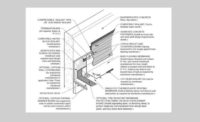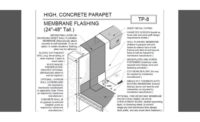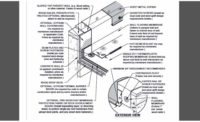
Detail courtesy of the Western States Roofing Contractors Association.
In situations where the parapet wall extends above the maximum 12-inch flashing height and wall waterproofing is required, there are several options. In the case of concrete or masonry walls: waterproofing can be provided by installation of a membrane covering, a metal covering or a waterproofing coating.
If the designer chooses to apply a waterproofing membrane, the following design techniques should be adhered to:
1. In cases where a modified bitumen sheet is used for flashing, it is a best practice to apply a second membrane flashing as the wall flashing. This material shall be applied over above the existing flashing, which should not extend above 12 inches up the wall. The flashing height is maximized due to the weight of the modified sheet and the susceptibility of slumping.
2. Attach a termination bar over the roof flashing to decrease possibility of slumping.
3. Apply the wall flashing over the roof flashing and termination bar.
4. Both wall flashing and roof flashing should be fully adhered to the wall substrate.
5. Fasten the wall flashing at the top of the wall every 6 inches on center.
6. Apply a coping over the wall flashing and fasten with self-tapping screws every 24 inches on center.

Detail courtesy of the Western States Roofing Contractors Association.








